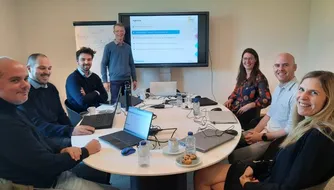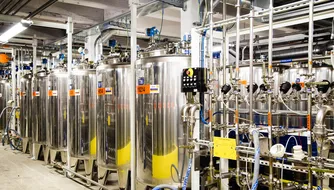Pipelife takes Supply Chain Management to the next level with Optimact

Creating a solid basis for a correct forecast. That is what made Pipelife Netherlands hire Xeleos Consulting. Now that its software package Optimact has proven its value in Enkhuizen, other branches of the company are discovering the software as well. Team Leader Supply Chain Planning Marcel van der Blonk, explains how the solution was successfully implemented at Pipelife.
Who is Pipelife?
For over fifty years, Pipelife has been developing, manufacturing and supplying a wide range of plastic pipe systems, fittings and tailor-made solutions for infrastructure, buildings and agriculture.
Typical application areas are indoor and outdoor wastewater pipe systems, cable protection, gas and oil transport and water management.
Forecasting as a bottleneck
Pipelife Netherlands manufactures both pipes and fittings. The organisation also buys parts from sister companies which it then distributes to customers. These customers are often technical wholesalers, but large water and gas companies, for instance, also call on Pipelife Netherlands. About 75% of the volume sold stays in The Netherlands. The remaining part is mainly exported within Europe.
Pipelife Netherlands offers approximately 15,000 SKU’s in total, about 3,500 of which are stocked in Enkhuizen. “The complexity of our forecasting is a major challenge for the organisation”, Marcel van der Blonk explains. “We already had a process for that in the past, but we didn’t have much confidence in it. We used Excel in combination with the forecasting module of our ERP system. But the more we grew, the more clear it became that our forecasting had to improve. Moreover, we had too much obsolete stock, which we wanted to get more grip on.” In its search for a solution, Pipelife Netherlands came across Xeleos Consulting. “They happened to contact us themselves just when we needed them. Obviously, we looked at some other parties as well, but after the selection process – which included a number of testing rounds – Xeleos turned out to be the most suitable partner”, says Marcel van der Blonk. “What struck us most, is that they paid much attention to our supply chain processes. Furthermore, the high level of flexibility of the Optimact cloud solution was the deciding factor. Other solutions seemed to offer far less customization options.”
Step-by-step approach
In agreement with Xeleos Consulting, Pipelife opted for a “first things first” approach. “While analysing the possibilities of the software package, we also questioned the key stakeholders about their main expectations. Again, the importance of a better forecast came forth. It was therefore obvious that this issue had to be dealt with first.”
After the necessary preparations had been made, the forecast from the existing system was compared with the calculations in Optimact. Together with the various sales people, it was examined to what extent they differed and whether the results from Optimact were in line with expectations. On the basis of those results, further fine-tuning was carried out. “It was only after the forecasting part had been extensively tested and evaluated, that the decision was taken to tackle inventory management”, says Marcel van der Blonk. “At that moment we could also start to dispose of our obsolete stock. In retrospect, I can only recommend that step-by-step approach.” During the implementation, the great flexibility of the package became clear. “We did add some customization”, Marcel van der Blonk explains. “The great thing about Optimact is that it offers a solid basis on which you can build further. For example, it was important to us that we could cope with the complexity that batch sizes entail. Since it is expensive to have our machines produce, we obviously want to do this as optimally as possible. For example, we must be able to add four cost levels on the manufacturing side in order to make the comparison with the inventory cost. This requires complex calculations, which fortunately we were able to integrate smoothly into the system.” A major challenge during the project was establishing the necessary interfaces. “We needed quite a lot of support in this, especially because we had to part with one of our own project team members at the beginning of the process. That is also the reason why the whole project was somewhat delayed. Fortunately, we could always count on the support of Xeleos Consulting.”
More insight into processes
Now that the most important stepping stones have been laid, Marcel van der Blonk looks back on the project with satisfaction. “The biggest advantage is that we now have much more insight into our forecasting and inventory management processes. This allows us to identify where things go wrong, so that we can intervene and improve in a goal oriented manner. Particularly in these uncertain times it is a must to have that transparency.” The figures also show an improvement in various areas. For example, delivery performance has increased by one and a half percent. Stock rotation has improved by ten percent, mainly because there is now a better view of obsolete stock.
An eye for continuous improvement
Of course, it is important that Optimact evolves along with the organisation. “Following on the optimisation of our forecasting and inventory management, we want to connect the system to our Master Production Scheduling next year. We want to switch to a group-wide MPS, which will allow us to switch between different products at a higher leve.l” In addition, while Optimact is running at Pipelife, some important improvements have been made to the package itself. “We notice that Xeleos Consulting is making an effort to put on the finishing touches. For example, they are now examining whether the seasonal profiles within the forecast can still be improved.” In the meantime, Pipelife Netherlands has also received an extensive reporting module. “This has proven to be very valuable for making things more transparent at a higher level”, says Marcel van der Blonk. “We are currently training a number of key users so they know how to read those reports and extract the data from them. Today, five employees work with the system in our two Dutch branches. That number will be extended to about fifteen employees in the short term.” A capacity dashboard was recently added to the system as well. This dynamic tool allows to make simulations, so that Pipelife Netherlands can, for example, check what would happen to its capacity if a particular business increased and can make the necessary investments. Work is currently being done to better align the budget with the forecast. This way, even better decisions can be made in terms of capacity and the investments required in
the machinery to serve customers optimally. In this way, the organisation wants to achieve even more end-to-end processes.
Rollout across other branches
Given the positive experience with Optimact at Pipelife Netherlands, the solution is now being rolled out in Belgium and Estonia. The intention is to provide the other European branches with Optimact as well in the future. “This will allow us to further standardise across all sites. In that case it is reassuring that with Optimact we have the same solid basis everywhere but can still make the necessary adjustments to suit each specific location”, Marcel van der Blonk concludes.


